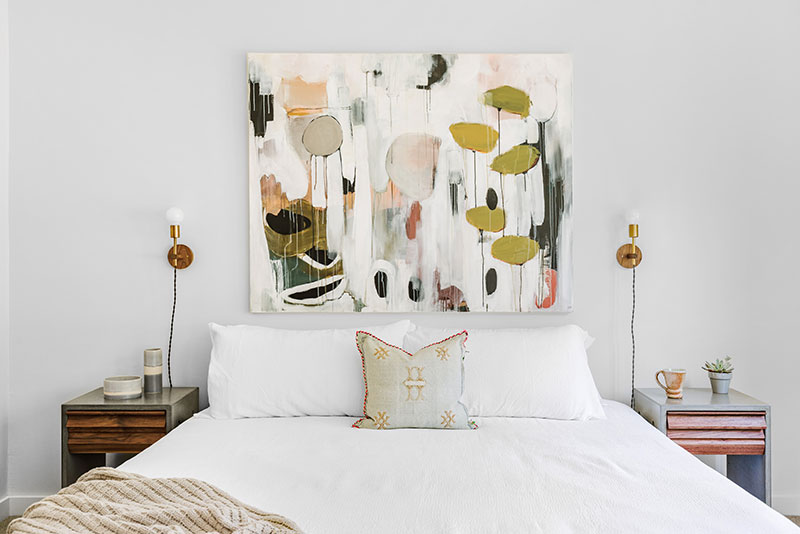Advertisement
Wall art — it’s nothing new. Murals have existed for thousands of years, and it has been widely hypothesised that Palaeolithic humans used cave art for aesthetic purposes and to represent ideals of beauty. Today, wall art is often neglected as the final phase in the interior design process. Only when the paint has dried, furnishings arranged and budget scrutinised do we turn to art as an afterthought.
However, there are many benefits of wall art. Not only does it add character and creative flair to any home, regardless of space and budget, but studies have argued that it can even be good for our mental health.
Still not convinced? Here’s why you should be thinking about wall art when it comes to the interior design of your home.
1. It adds texture
In interior design, texture is also known as ‘visual weight’, and ultimately, it’s what makes a room ‘pop’. However, texture is often misinterpreted as merely a tangible quality — actually, it has striking visual benefits too, and can be embraced using a variety of home furnishings, especially wall art.
There are numerous pieces to choose from to bring texture into a room, from tapestries to wall-mounted plants to three-dimensional fixtures. However, a stylish and timeless method is to use framed artwork. Many interior designers incorporate texture through their choices of art and frame style.
Framed art should be layered purposefully alongside other furnishings to enhance a room’s depth. The colour, material and structure of a frame are important to consider, as is the placement of a piece. If in doubt, consult the services of an expert: London-based Soho Frames, for example, offer in-person and remote consultations, plus 3D renderings of the environment in which the art is to be hung.
2. It creates a focal point
One of the most important aspects of interior design is a focal point in a room, but what is this exactly? Essentially, a focal point is a feature or characteristic of a space that draws our attention — it’s the first thing we notice when we walk in, and it’s around this which other décor should be anchored.
Any room may be transformed into having an individual focal point. Firstly, consider what’s available already. Is there an accent wall, fireplace or large bank of windows to work with? Or, to keep things fresh and interesting, perhaps an emphasis on interchangeable focal points could be the way to go — such as a statement rug, sofa or chandelier. However, the easiest (and arguably the best) method to draw the eye is by the creation of a gallery wall or hanging an impactful piece of artwork.
A large or eye-catching piece of art can easily carry a room by itself. Although, in order to maximise the impact of your focal point, keep the rest of the interiors understated so the art can take centre stage. But you don’t have to use one large framed piece to establish a focal point. With the right combination of images and prints, ideally in the same style, colour or theme, you can transform a simple collage into an impressive, attention-grabbing focal point.
3. It reflects your personality
The art that a homeowner chooses can reveal a lot about them. However, when it comes to buying art, many people have concerns over their choices: Will I like it in five years’ time? How much should I spend? Will it match my décor? The beauty of art is that it allows you to display a piece of your personality on your wall and uniquely represent your aesthetic, character and interests.
Wall art can also offer fantastic opportunities for sparking deep conversation, opening the mind to new forms of expression and promoting the sharing of ideas and opinions. Therefore, to transcend small talk and drive creative conversation with your guests, display meaningful pieces that speak to you. If you are unsure where to start, websites such as Society6 offer a wide variety of low-cost prints that can instantly inject personality, colour and intrigue into a room.
If you have the funds, investing in an original is one way to create an impressive and interesting focal point — one that will certainly intrigue and lead to engaging conversation. Willow Gallery, based in London, offers a wide range of Impressionist, Modern and European paintings, including works by Edward Cucuel, Montague Dawson and Henri Lambasque. Otherwise, purchasing art from up-and-coming painters could be a cheaper option to invest in an original piece.
4. It gives a room a finishing touch
Have you ever entered a room and thought to yourself, “something is missing”? More often than not, that something is wall art. The minimalist movement is undoubtedly in right now, although overly-plain walls can quickly feel clinical, incomplete or downright uninspiring. However, a suitable piece of wall art can easily fill this void. Wall art is the finishing touch that brings a room together and enables it to seem finished. This extra flourish can transform your home from practical to personal.
Consider what may be missing in a space. Is it too neutral? Too bare? Inconsistent? Once you identify what the area needs, you can opt for artwork that complements the room. Play around and be adventurous. Mix and match, arrange items in unexpected ways and see how it feels. Nothing needs to be static — experiment until you find a configuration that suits the room’s existing style, theme and furnishings.

